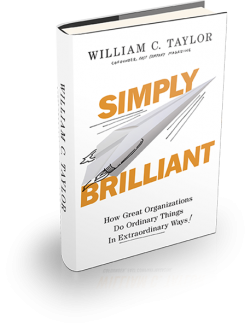Latest Newsletter

Three Ways to Unleash Positive Energy in Exhausting Times – November, 2022
I don’t know about you, but I’m tired—exhausted, really.
The last two-and-a-half years have demanded so much of us as leaders, colleagues, family members, and citizens. It’s not just the pandemic and public health, inflation and economic turbulence, or elections and social divisions. It’s all of that, all at once, plus, when it comes to our responsibilities as executives, entrepreneurs, and leaders in all sorts of fields, the need to simultaneously perform and transform—to deliver stellar results for the present, even as we invent all-new strategies and practices for a disruptive future.
So we need lots of creative ideas, different models of work and collaboration, richer definitions of success. But above all, we need some bursts of energy and inspiration—ways to unleash exciting experiments, rally our colleagues to support an agenda for change, and bring out the best in everyone around us.
The late Stanford professor John Gardner, who believed in the power of what he called “tough-minded optimists,” famously wrote that, “The future is rarely shaped by people who don’t believe in the future. It is created by highly motivated people, by enthusiasts, by men and women who wants something very much and believe very much.” In other words, by leaders with lots of positive energy. This newsletter (which I will try to keep short, since you may be too tired to read to the end), offers three simple strategies to unleash positive energy inside your organization, among your colleagues, and within yourself.

“The future is rarely shaped by people who don’t believe in the future.”
The first strategy is to develop new ideas about where to find new ideas—in particular, to embrace the value of learning from strangers. One reason the last few years have felt so exhausting is that we are being asked solve problems we haven’t seen before, to serve customers in ways we haven’t served them before, to deal with emotions we haven’t experienced before.
But that does not mean we have to innovate from scratch. I believe the fastest way to get to the future is to learn from experts and innovators who do similar work to you, but in unrelated fields. Why gamble on untested strategies and insights if you can apply strategies and insights that are already proven elsewhere?
In an essay for the Harvard Business Review, I describe how one big-city hospital, during the worst of the Covid pandemic, built up the energy of its exhausted and dispirited staff by borrowing concepts, techniques, and language for renewal used by the U.S. Army with troops in combat zones. I also describe how a change-minded Chief of Police in Providence, RI pushed his detectives to open their minds to new ways to solve cases by sitting in with doctors and surgeons at a nearby hospital, to observe how they cracked tough medical cases. The lesson: Proven ideas from one field can become a powerful force for learning and change when they migrate to another field. What better way to fuel your imagination than to look for inspiration from outside your field?
You can read my Harvard Business Review piece here.
There’s a second way to unleash positive energy for change, and it almost the inverse of the strategy I just described. Instead of looking outside your organization, look inside your organization, but look at your colleagues differently from how you have seen them before.
These days, there’s no question that many leaders and organizations ask too much of people; they create pressures to perform that feel unhealthy and unsustainable. Lately, though, I’ve been wondering if leaders and organizations also ask too little of people; they overlook skills and experiences that don’t conform to official job descriptions or traditional business relationships, and thus miss out on the passions and talents of colleagues and customers who would be eager to share what they know, if only they were asked. One of the most energizing ways to make your organization more successful is to invite more people to contribute more of themselves to its success.
In another essay for Harvard Business Review, I wrote about a fascinating initiative at the Baltimore Museum of Art, which empowered 17 of its security guards not just to keep watch over the museum’s many exhibits, but to curate an exhibit of their own based on their personal interests, passions, and knowledge. It’s easy to understand the heart-warming appeal of this artistic initiative, and the lessons it holds for cultural institutions looking to shake up their stuffy ways of doing things. But it also holds a tough-minded lesson for leaders and companies in all sorts of fields—a lesson about how certain kinds of brainpower and talent often get ignored, and the value of tapping this overlooked talent inside and outside the organization.

“One of the most energizing ways to make your organization more successful is to invite more people to contribute more of themselves to its success.”
I also describe an experiment by a world-famous she designer to invite his most passionate customers to design the shoe of their dreams—designs that he then manufactured, to great success in the marketplace. The lesson is as simple as it is powerful: most companies are staffed and surrounded by employees, customers, suppliers, and fans who are passionate about what the company does, bursting with ideas, and eager to be more involved. Why not invite them to express their creativity, wherever they may be in the org chart or in the world, to help you solve problems and drive change?
You can read my HBR Article here
I will end this newsletter with a third piece of advice—not so much a strategy, as a choice that we as leaders all have to make. Another reason the last few years have felt so exhausting relates to one of the timeless challenges of being a leader: How do I persuade people to do things they would rather not do? Social scientists have been debating that question for decades, and they have identified two different answers—each of which can work in the right situation, both of which can help leaders think about the hard work of making change.
One answer, which psychologists call the “foot-in-the-door” technique, is that the best way to get people to change something big, or do something hard, is to first ask them to change something small, or do something easy. By agreeing to the request, and then meeting it, people develop a sense of commitment and confidence that makes them more enthusiastic about agreeing to the next (bigger) request.

“A make-or-break question for leaders: How do I persuade people to do things they would rather not do?”
There second answer is to insist that people do something even bigger and more dramatic than what you actually have in mind, and then when they refuse or resist, your change agenda seems tame by comparison. Psychologists call this the “door-in-the-face” technique. In a landmark article evaluating an alternative to the foot-in-the-door approach, researchers asked, “What would be the result of making an extreme first request which is sure to be rejected and then asking for a more moderate second” request?
The answer, it turns out, is that people are far more likely to go along with the second request. In a third essay from Harvard Business Review, I explores both techniques and describe situations where a “foot in the door” might work better than a “door in the face,” and vice versa. Ultimately, there is no one right way for leaders to summon the energy for change.
You can read my Harvard Business Review essay here.
Well, I have lots more to say, but frankly, I’m too tired to write it and you’re probably too tired to read it! Thanks as always for your interest in my ideas. Best of luck as you summon the energy for positive change in these strange and trying times.
Happy Holidays. I will be back in touch after the New Year.
Best,
Bill Taylor
